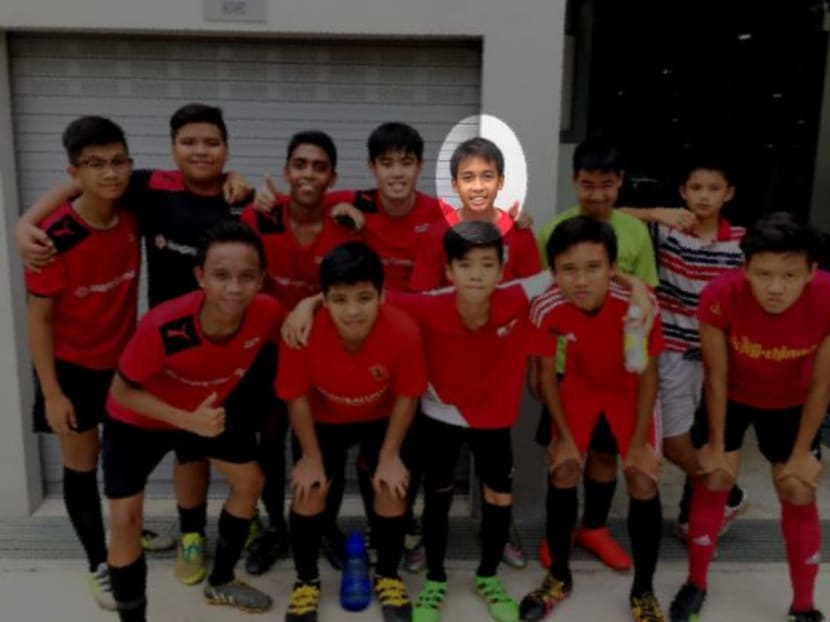MOE bans schools from using foldable goalposts for football games
SINGAPORE — The Ministry of Education (MOE) has issued enhanced safety guidelines to all schools on the use of football goalposts, banning foldable ones, and it is getting them to implement these by the end of the year.

Muhammad Hambali Sumathi (back row, third from right) and his team mates from the boys’ football club, Youth Guidance Ethos. Hambali was killed in April after a goalpost collapsed and struck him on the head during a football game. Photo: Youth Guidance Ethos
SINGAPORE — The Ministry of Education (MOE) has issued enhanced safety guidelines to all schools on the use of football goalposts, banning foldable ones, and it is getting them to implement these by the end of the year.
This comes after a student from Geylang Methodist School (Secondary), 12-year-old Muhammad Hambali Sumathi, was killed in April after a crossbar of the goalposts collapsed and struck him during a match.
During the inquiry into Hambali’s death on Monday (Sept 18), State Coroner Marvin Bay said that Hambali grabbed the crossbar in frustration, and along with his likely struggle to untangle his legs from the net, these would have destabilised the structure and caused the crossbar to buckle.
As part of the enhanced guidelines, schools have been instructed to dispose of any foldable goalposts they have, and put warning labels on the crossbars of goalposts that are 1.8m and taller.
All goalposts must be anchored to the ground using suitable means and should either have built-in counterweights within their frame, or be capable of being anchored securely to the ground.
Students must also be briefed on the proper use of facilities — such as the fitness stations or weights in fitness rooms — and should be warned not to hang or climb onto any equipment not meant for such purposes.
Mr Bay described the death of the Secondary 1 student as “a most tragic misadventure”, noting that there was no basis to suspect foul play.
The cause of death was given as a head injury.
At about 9.30am on April 24, Hambali was playing football with his classmates as part of their physical education (PE) lesson.
During the game, he set up a potential goal for his teammate, but when the teammate failed to score and missed the shot, Hambali became “demonstrably frustrated” and was heard shouting angri-ly.
He then ran towards a white, mobile, full-sized goalpost frame, which was placed outside the playing space and not being used for the lesson.
Hambali, who was 1.69m tall and weighed 47kg, jumped and grabbed its crossbar and got his feet entangled on the net.
This was when crossbar buckled and hit him on his head.
After he fell to the ground, the bar fell on him a second time.
The court heard that the school bought the mobile frame in 2014.
A PE teacher at the school, Mr James Lim Boon Tiong, said that the back bar of the goalposts had fallen off several months, or even a year before the incident, and had become corroded.
He also recounted that the while the sides of the structure were secured by a bolt, it had “never been secured tightly all the way”.
This was because students and teachers would frequently move the goalposts by tilting the sides until they were parallel to the ground, and carry the frame at waist level.
There “was never any cause of concern” about the bolt not being secured all the way because the crossbar could still stand and withstand the impact of balls being kicked against it.
In his findings, Mr Bay said that when Hambali grabbed the crossbar at a spot closer to the left side, it imposed an asymmetrical stress that destabilised the left side of the frame.
As the boy was likely to have struggled to free his entangled feet, “the combination of imposed stresses proved too great for the loosely-bolted trapezoid sides of the goalpost”.
Commending the school and MOE for proactively taking such measures, Mr Bay said that there is “always a need to anticipate the possibility that students will use or misuse equipment in an unexpected, unorthodox, or otherwise unsafe manner, and expose themselves to injury”.
“Imbuing students and teachers with a keen sense of safety con-sciousness, along with close supervision of activities during PE sessions, would be key to alleviating this risk of harm,” he added.
In a statement last night, MOE told TODAY that the enhanced guidelines apply to all primary and secondary schools, junior colleges and its centralised institute. It communicated this latest measure to these schools in the “third quarter of this year”.
“Schools have been educating, and will continue to educate, students on the proper and safe use of school facilities,” it added.
Geylang Methodist School (Secondary) now displays signs on goalposts and similar sporting equipment to caution against the dangers of hanging, pushing or pulling on the equipment.






